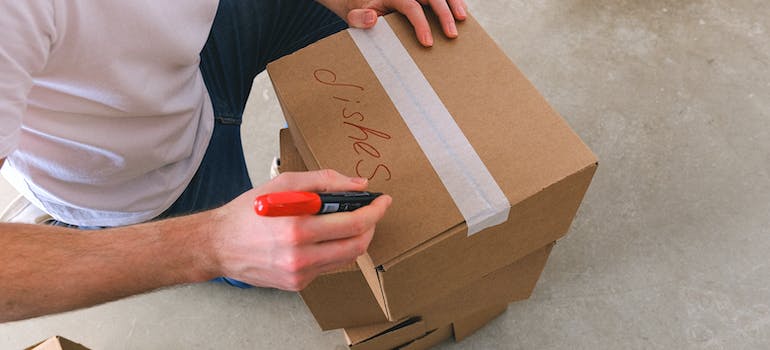Creating a Storage Plan: Sorting, Organizing, and Labeling Tips
Creating a storage plan is an important step toward reclaiming space, restoring order, and easing daily life’s chaos. Efficient organization transforms cluttered spaces into functional ones, streamlining accessibility to essentials while offering a sense of serenity. From decluttering to meticulous arrangement, this process involves strategic maneuvers to harmonize your belongings. You can always rely on the help from Best Cross Country Movers when it comes to moving. They will help you find some of the best movers for your needs. Find out more about the art of creating a plan that optimizes space utilization, sorting techniques, organizational strategies, and the crucial role of labeling in maintaining an orderly environment. Join us on this transformative expedition toward structured living!
Strategic Storage Plan Makes the Moving Process Much More Simple
Implementing a strategic storage plan before a move provides many benefits. Firstly, it significantly reduces stress throughout the entire moving process. By sorting, organizing, and labeling belongings beforehand, you can minimize last-minute chaos and searches for specific items. Secondly, a well-executed storage plan facilitates easier unpacking and settling in at the new location. Clearly labeled boxes and organized belongings streamline the unpacking process, allowing for quicker access to essential items and an easier transition to the new space. The strategic storage plan also ensures the efficient utilization of space in the moving vehicle or storage unit. Maximizing space minimizes the number of trips required and reduces the risk of damage to items during transportation, ultimately optimizing the entire moving experience.

Sorting Items and Decluttering
Decluttering plays a pivotal role in the efficiency of a move, making it essential to tackle before packing. It allows individuals to decide what to keep, donate, sell, or discard. Categorizing items into these distinct groups reduces unnecessary belongings, lightening the load for the move. A useful strategy is to assess an item’s usefulness and sentimental value to decide what to keep or let go. There should be an easy way to declutter sentimental items before the move: the ones that serve a practical purpose or hold sentimental significance should be retained, while those no longer serving a purpose or lacking sentimental value could be considered for donation, sale, or disposal. This process not only simplifies the packing phase but also ensures that only essential and meaningful items make their way to the new location, facilitating a fresh start with a more organized and purposeful inventory.
Organize Belongings to Maximize Efficiency
Efficiency in organizing belongings during a move relies on the effective use of storage containers and boxes. These tools optimize space utilization and safeguard items during transit. Grouping belongings by category or room further simplifies the organization process, ensuring items are packed together logically for easy retrieval. Additionally, organizing based on frequency of use aids in prioritizing items. Placing frequently used items in easily accessible containers helps avoid rummaging through multiple boxes leading to a stress-free unpacking process. Employing these techniques ensures an easier transition to the new location by facilitating quick access to essential items while keeping less-used possessions securely stored, enhancing efficiency and minimizing stress throughout the move.
Labeling for Easy Identification
Creating a storage plan involves a crucial aspect: clear and consistent labeling. It serves as a guiding beacon during the moving process, facilitating easy identification of belongings. Employing different labeling methods such as color-coding, detailed descriptions, and numbering systems on boxes ensures clarity and organization. Color-coded labels can quickly signify rooms or categories, while detailed descriptions provide specific information about the box contents. Utilizing numbering systems aids in keeping track of inventory and prioritizing unpacking. Moreover, for packing fragile items there are specialized labeling strategies, like using “fragile” stickers or marking boxes as “urgent,” to ensure these items receive extra attention and care. This meticulous approach to labeling safeguards items guaranteeing a smoother and more organized transition to the new space.

Different packing approaches to special items
To secure fragile belongings, such as glassware or ceramics, wrap each piece individually with bubble wrap or packing paper and place them in sturdy boxes with ample cushioning material. Clothes benefit from techniques like rolling or using wardrobe boxes to minimize wrinkles. Electronics require careful handling; pack them in their original boxes if available, or use padding and sturdy containers. Disassembling furniture for transport and covering it with blankets or furniture pads prevents damage. For miscellaneous items, organize them into labeled containers and use packing peanuts or paper for added protection. Utilizing appropriate packing materials and supplies, such as tape, markers, and different box sizes, ensures items are well-protected throughout the moving process.
Space Optimization in the Moving Vehicle or Storage Unit
Optimizing space within a moving vehicle or storage unit requires strategic planning. Arranging boxes and furniture efficiently involves placing heavier and sturdier items at the bottom and filling gaps with lighter ones to prevent shifting. Utilize vertical space by stacking boxes and disassembling furniture where possible. Employ tie-down straps or ropes to secure larger items and prevent movement during transit. While maximizing space is crucial, safety shouldn’t be compromised. Distribute weight evenly and avoid overloading to prevent damage. Creating pathways within the storage area facilitates easy access to items, allowing for quick retrieval without the need for rearranging everything. By balancing space optimization and safety measures while maintaining accessible pathways, the moving process becomes more manageable.
Settling Into Your New Living Space
Upon arrival at the new location, unpacking becomes more efficient with a meticulously crafted storage plan. Following the plan’s guidelines, start by unpacking essential items, such as bedding, kitchen essentials, and toiletries. Organize boxes by room, utilizing the labels and categorizations from the storage plan. The storage plan’s systematic approach fosters easier organization in the new home, allowing for quicker placement of items in their designated areas. Efficient unpacking involves setting up one room at a time and prioritizing functional spaces like the kitchen and bedrooms. Additionally, when arranging furniture, refer to the storage plan’s initial strategies, ensuring furniture placement aligns with the intended room layout. Implementing these unpacking will make settling into your new home a comfortable experience, without any complications and headaches.

Start a Life in Your New Home Easily by Creating a Storage Plan Before the Move
The significance of creating a storage plan for a successful move cannot be overstated. This meticulous approach, involving sorting, organizing, labeling, and strategic packing, proves instrumental in reducing stress, expediting unpacking, and optimizing space utilization. By implementing these strategies, individuals pave the way for a better transition into their new environment. Encouraging readers to try these techniques for their upcoming moves ensures a more organized and efficient relocation process. The groundwork laid by a well-thought-out storage plan sets the stage for a more comfortable and hassle-free settling-in period!





